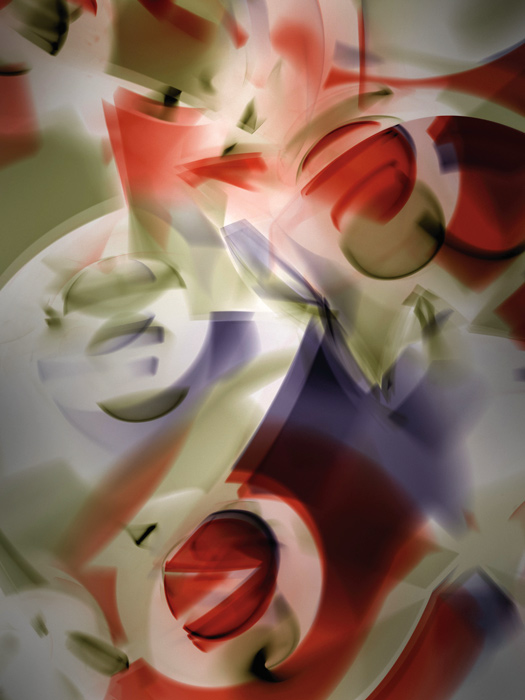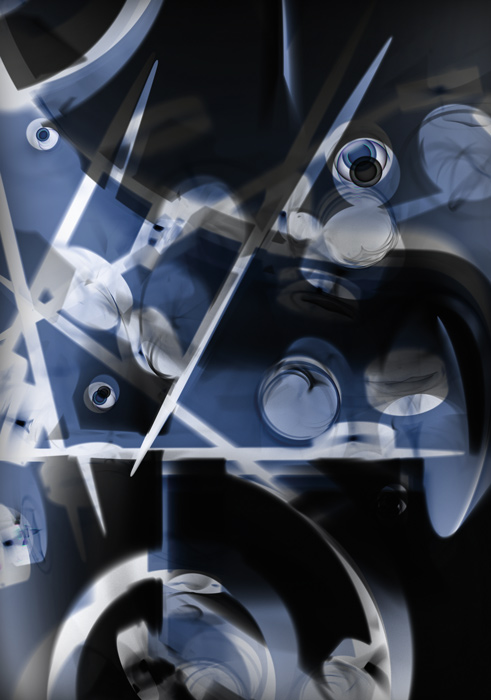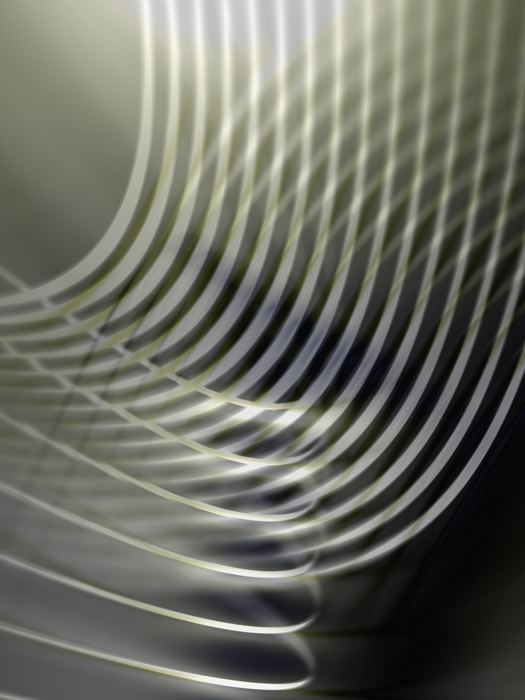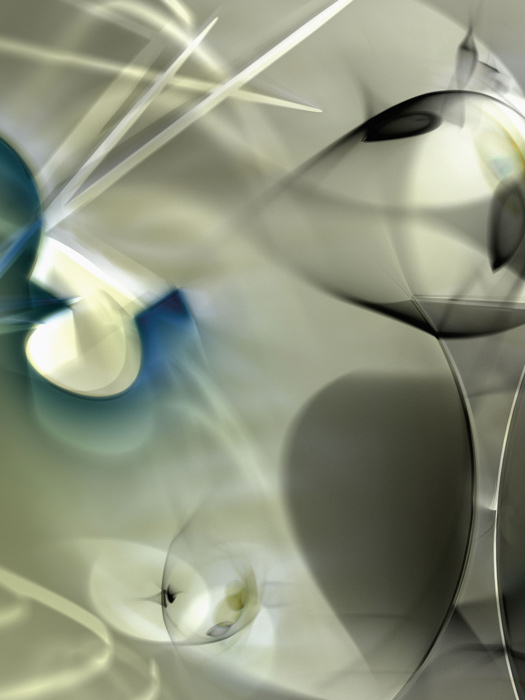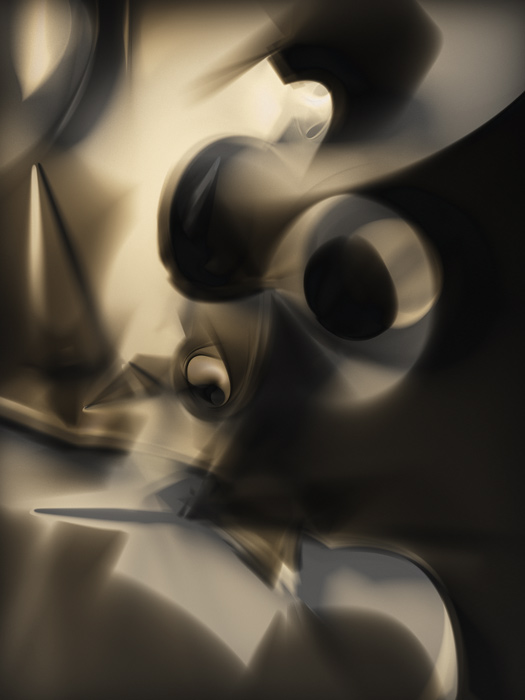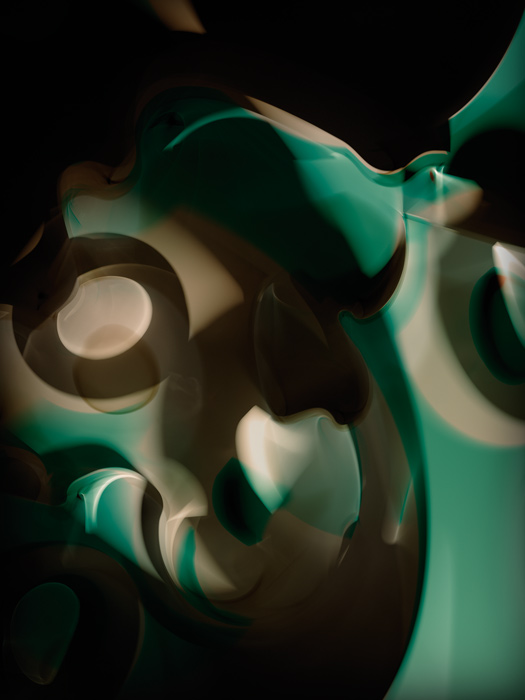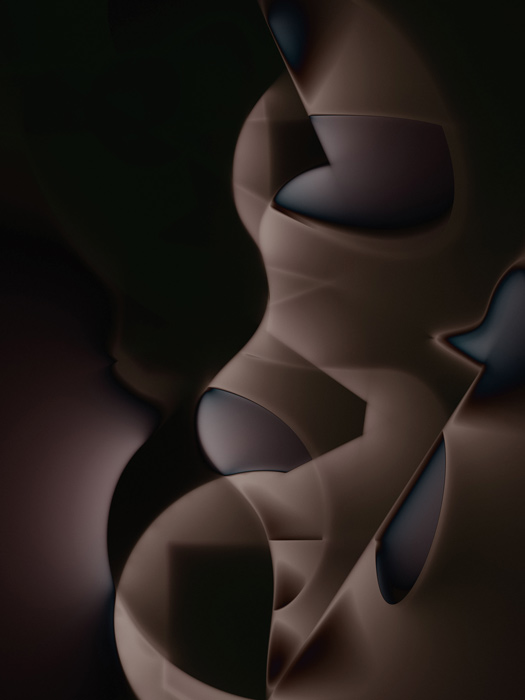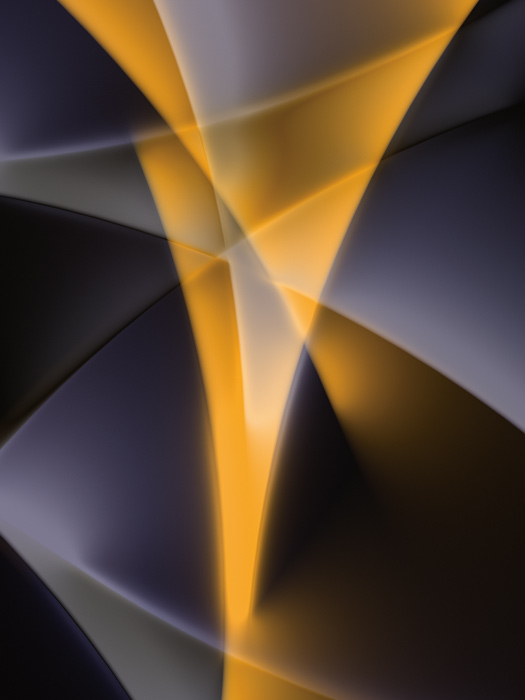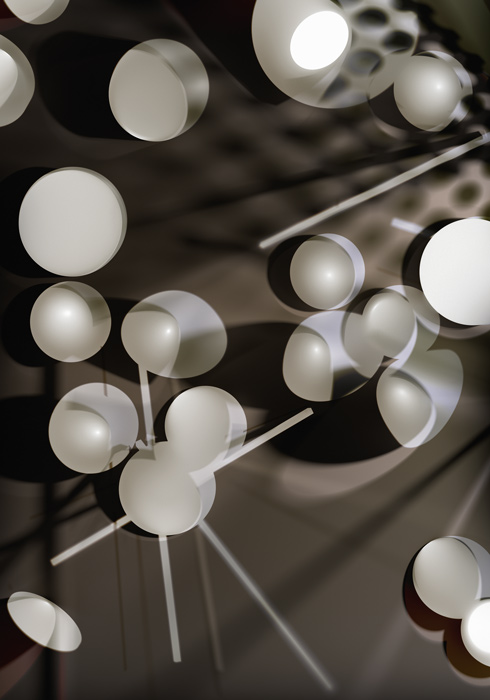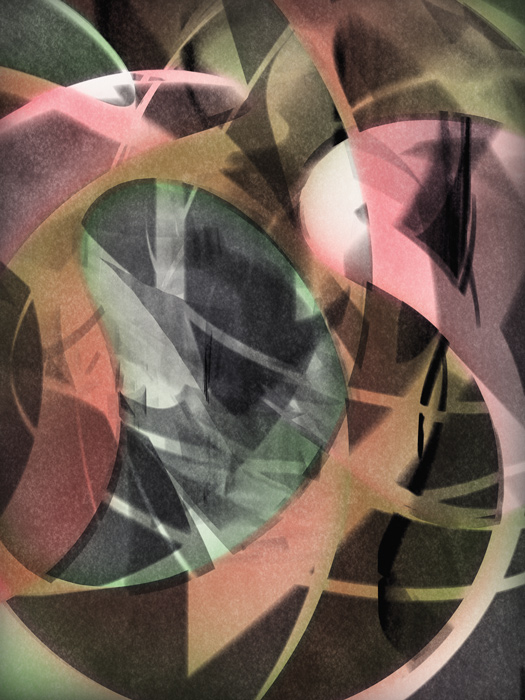By Jacinto Lageira
Given the impossible computer-made “photograms” in Thomas Ruff’s recent series – thus in line with Moholy-Nagy’s idea that one can make photographs without a camera (he made his own photograms) – we must immediately consider either a broadening of the notion of photography or its being subsumed, pure and simple, in another visual medium. That Ruff called these strange images photograms, and that they resemble renderings and elements obtained in a traditional manner on photosensitive paper, is not just a play on paradox; these images are actually challenging ideas about medium, material, image, and representation. But is this project so radical in the contemporary art world, which now encompasses countless technological innovations and enormously diverse media? It is certainly not the technical achievement on its own that is impressive, even though we might admire the forms, colours, and formats – which are admirable precisely because they look somewhat like photograms made during the 1920s and 1930s. In fact, the instant that we are drawn to the plays on imitation and resemblance, we realize that these images are actually diametrically opposed to the photogram process, as they were made on a computer. But if Ruff has taken the care to give them this label, perhaps we should take a look that goes beyond just curiosity or regarding them as an amusing experiment.
First, we should remember the apparent truism, which is often ignored or minimized, that traditional photography (both silver and digital) is certainly, from the physical and mechanical point of view, closely related to its model – the object, person, or subject photographed – but has no privileged access to this model. From a strictly pragmatic point of view, the reality of the thing represented is certainly more easily transferred into its representation (the final photograph), but this representation remains, by nature and by definition, an image of the thing represented, and is not that thing immanent, present, accessible, and knowable as such. The ontological status of the representation is questioned both by way of its medium and inasmuch as it refers to a reality that is understandable only through different systems of representation – perceptual, language-based, physical, or biological. In order to state definitively that a photograph is an image of reality, we must know, independent of the medium in question, what this reality consists of, and this is far from taken for granted.
Because a photogram is, by definition, a shape-image obtained by direct contact between an object and photosensitive paper and direct contact with or absence of light flows, Ruff’s “photograms” cannot be photograms in the strict sense. His images are computer generated, and the final referent is thus the software that calculated them. Of course, a traditional photographic image is physically and mechanically closer to the model, which is exterior to it and exists in the world. It must be recognized, however, that the true truth or the real reality that is attached to such an image is also a construction dependent on sociocultural contexts, codes, and semiotic modalities. Although we cannot deny that Ruff’s “photograms” are utterly invented in comparison to traditional photographic images, which are made according to that which came before them, nor can we deny that traditional photography is not reality in and of itself. There are thus gradations in the reconstruction of reality that depend on the medium, which ranges from the image or sculpture by contact and imprint to representation by computer processes.
Ruff has explored these various gradations. From his early portraits, which long bore the trademark of a certain German school, to today, he has gradually abandoned the live model for images that are re-edited, found, blurred, almost unrecognizable, remade, manipulated – to the point that the images in the recent series of photograms no longer owe anything to any pre-existing model that one might find in the environs. His previous photographic series, featuring human faces composed of different parts of other people’s faces and assembled in a nonlinear manner, or a third face obtained through superimpositions, already posed a challenge to what is, or may be, reality. Which, in the end, was the person’s true face? Ordinary photographic effects, all true and authentic in the traditional conception, thus became fictions through manipulation and recomposition – which leads ineluctably to the observation that the medium, in itself, is not true, real, or authentic, at least no more than any other. Rather, it is how the functions are manipulated that position the medium, or not, or to a greater or lesser degree, in a regime of realism or reality.
The trick of Ruff’s “photograms” is that he is imitating the abstract photograms of the avant-gardes, in the sense that it was not possible in those photograms to recognize the elements, as concrete as those elements might have been, that were used to make them. And the more concrete the object was, the more the image tended toward the nonfigurative. Things are reversed here, as Ruff wants to imitate abstract or nonfigurative forms of other images that were intended to evade any mimesis. For when it came to the process making an image of the thing represented, it was inevitably very concrete and present, as it would be impossible to make the photogram in the absence of contact and imprint. These two referrals to reality (old photograms or Ruff’s photograms) – or to two very different realities – obviously demonstrate that one can very well produce the imaginary and the unreal both with the most concrete processes and with completely autonomous technological processes that are not based on an exterior reality. And so, it is a significant paradox that Ruff’s “photograms” refer, by imitation, to the reality of the photograms of Man Ray or Moholy-Nagy, for example, and thus to the representation of reality, or of a certain reality – the reality that has long been the fundamental framework for Western aesthetic production. And although this is not an imitation of an imitation – as it is an imitation of a very material reproduction obtained by imprinting – Ruff refers at least to a true and authentic reality that would be the very material of the traditional photogram. For this material, the photosensitive paper of the avant-gardes’ photograms, is well and truly concrete, compared to other, equally material objects in the world, but it is nevertheless not a representation of reality, nor even without doubt an image of that reality. The terms imprint, trace, deposit, residue, and contact are much more appropriate for describing the process than the result.
Due to Western artistic and aesthetic paradigms of mimesis, we still see as more real or containing more reality a work whose elements are recognizable – or sufficiently recognizable that we can connect them to the world. For this reason, it has been difficult to conceive of abstract or nonfigurative art being as real or capable of representing reality. Yet, a fictional, imaginary, completely invented object (not taking after or inspired by something that already exists) possesses as much reality as does an object arising from imitation. Even if not all representation is imitation, still, all representation is real or arises from a reality, even a fictional one. Ruff’s series succeeds in presenting us with another way to approach and practise reality. This is not a simplistic reality in which the false does battle with the real, the fictional with the document, the fake with the authentic, but a reality made of fine gradations, gradual transformations and mutations, indistinct modifications, by degrees, which is another way of telling us that the very process of reality is a very complex dialectic.
Translated by Käthe Roth
Thomas Ruff was born in Zell, Germany, in 1958, and he lives and works in Düsseldorf. In the early 1980s, he decided to devote himself to photography and became a student of Bernd Becher’s at the Kunstakademie Düsseldorf. He had his first solo exhibition in 1981. He is represented by the Gagosian Gallery and the David Zwirner Gallery.
Jacinto Lageira is a professor of aesthetics and philosophy of art at Université Paris 1 Panthéon-Sorbonne, and an art critic. Among his published works are L’image du monde dans le corps du texte, 2 vols. (Brussels: La Lettre volée, 2003); L’esthétique traversée – Psychanalyse, sémiotique et phénoménologie à l’œuvre (Brussels: La Lettre volée, 2007); La déréalisation du monde. Fiction et réalité en conflit (Paris: éd. J. Chambon, 2010); Jean-Marc Bustamante: Cristallisations (Arles: Actes Sud, 2012); and Regard oblique. Essais sur la perception (Brussels: La Lettre volée, 2013).

